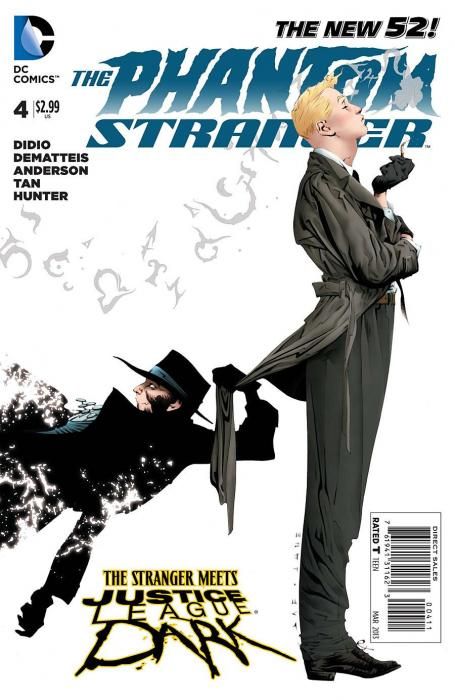Continuing to investigate the notion of Phantom Stranger maintaining a double identity like so many other DC characters, Dan DiDio welcomes J.M. DeMatteis to the creative team on scripts. DeMatteis makes an instant impact on this book, not only further humanizing the familial aspect of the character, but also shining up the dialog for the intimidating, fedora-topped, cloaked Phantom Stranger as the title's star has a visit with the characters from "Justice League Dark."
On what appears to be a recruitment call, John Constantine picks the brain of the Stranger and teases him a bit, dangling carrots to try and win the Stranger's allegiance in coming trials and tribulations. The conversation between the two characters is haughty and aloof, with each man posturing and trying to place his cause higher than the other's. Unfortunately, adding in the rest of the "Dark" cast undermines some of the character work that Jeff Lemire put into them. I find Frankenstein's reaction to the Stranger's counterattack to be out of character and disarming. Deadman and Xanadu remain true to form and help affirm the Stranger's abilities and potential, but the critical takeaway from the conversation is the motivation Constantine holds on the Stranger.
My earlier assessment of the Phantom Stranger as a creep does not have room to play out here, as DeMatteis and DiDio focus on coordinating the events of the future and sizing up the Stranger's role in those events. The deepening of Phantom Stranger's Philip Stark persona makes the apparent loss he suffers in this issue scary and disconcerting and decreases the frightening potential the character could have if unfettered. That said, the end of "Phantom Stranger" #4 is a sure hook for any fan of DC's supernatural characters as Stranger receives a visit from another Trinity member and a surprise cameo certain to play out in more depth next issue.
The low point for "Phantom Stranger" #4, for me, is the art. It's not bad, but it's not grand either, it simply does the job of telling the story. It's rough and sketchy, dirty and shadowy. In and of itself that would be appropriate for the dark-tinged tale going on in this comic book. In fact, black and white art might be better suited to a horror-tinged comic like this. Ulises Arreola's colors, however, are delivered in a pseudo-watercolor style that does less to accentuate the black and white linework and does more to muddy up the visuals. Anderson's lines use traditional crosshatching and reflections to indicate light and shadow, depth and dimension, but more than once the coloring doesn't cooperate with the presumed intent of Anderson's lines, seeming like bad sunburn. Arreola's effects are strong, however, which comes in quite handy in a comic where the titular character frequently has glowing eyes and interacts with the mystical and unknown.
After reading "Phantom Stranger" #4 and reflecting on it a bit, I found myself wondering, "Could the Trinity War not be about people, but rather about Justice Leagues?" After all, Constantine introduces his group as "Justice League Dark" in this issue and we have seen some conflicts of interest between Constantine and Steve Trevor, known to be associated with the upcoming "Justice League of America." Yes, that's boundless speculation, but good stories inspire imagination and "Phantom Stranger" #4 has, at least, ignited a spark to inspire thinking about the future of the DC Universe. It's also enough, thanks in no small part to DeMatteis guiding hand, to summon me back for more soon.

